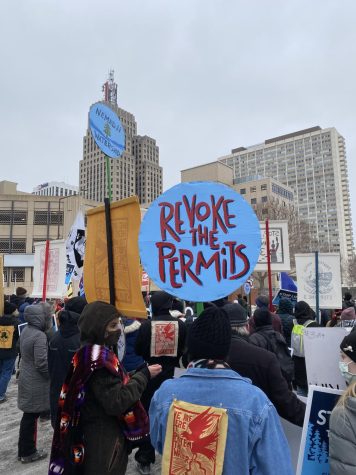Looking at Line 5’s long, environmental battle with the upper Midwest

Six hundred and forty-five miles of pipeline stretch across the upper midwest to make up Line 5, a pipeline transporting crude oil across 360 of Michigan’s waterways. Enbridge’s Line 5 runs from Superior, Wisconsin, the twin city of Duluth, to refineries in an Ontario town called Sarnia. Line 5 carries oil sourced from Alberta tar sands, moving through American soil to eventually convert the oil to petroleum back in Canada. Not only does the pipeline carry oil, it poses a threat to surrounding Indigenous communities and the environment it runs through.
Tar sand extraction is a dirty industry; processing oil from tar sands emits three times the greenhouse gasses as conventional crude oil extraction does. The Alberta tar sand fields sit in an isolated part of Canada, spanning an area larger than England. The gold residing in these large fields is called bitumen, a heavy tar-like substance that resides deep beneath the surface and requires large amounts of water to extract.
Tar sands are transported through pipelines to reach refineries, usually further South. For 55% of Michigan’s propane, that oil travels through Line 5.
Line 5 was built in 1953, and is deteriorating, posing a threat to the surrounding ecosystem. Additionally, Line 5 runs through the Bad River Reservation of Lake Superior Chippewa Treaty Territory. The easement that allowed Enbridge to operate through the tribal area expired in 2013, but the pipeline has continued to run through tribal land illegally.
“Pipelines that go through Indigenous land harm Indigenous resources, which have already been severely restricted by the United States and Canadian governments,” senior Becca Richman said.
This outrage is common; in 2020 the Bad River Band sued Enbridge for trespassing on their land. In response, Enbridge proposed a reroute of Line 5 due to its deteriorating state and threat to the Bad River Reservation. The new route would no longer run through the Reservation, but tribal leaders have expressed discontent that it is still too close to the tribe’s water resources.
Pipelines are pointless. We have an entire economic system based on landwide transport; why don’t we use that?
— Becca Richman
Environmental activist group Sierra Club reports that Line 5 has had 29 oil spills since its construction in 1953. In contrast, Enbridge maintains that the pipeline has never caused environmental damage based on data from their computerized leak-detection systems. National Wildlife Federation (NWF) researchers estimate that 1.1 million gallons of oil have been spilled over Line 5’s lifespan. Enbridge’s leak-detection system only found one of them.
Line 5 illegally runs twin pipelines through the Straits of Mackinac, waterways connecting Lake Huron and Lake Michigan. The 1953 easement allowing Enbridge to operate Line 5 through the Straits was terminated in 2020 by the Michigan governor, yet the pipeline still operates.
Currents move powerfully through the Straits of Mackinac, meaning an oil spill in the area would be catastrophic. An oil spill in the Straits could contaminate up to 150 miles of lake shoreline, and 100 square miles of aquatic habitat unique to the area housing over 47 conservationally concerned species.
“Pipelines are pointless. We have an entire economic system based on land wide transport; why don’t we use that? That’s much less dangerous for the environment, and can be more environmentally friendly if we use electric vehicles,” Richman said.
Oil spills are no easy cleanup. It is estimated that only 30% of oil could be recovered if a spill did occur in the Straits and it would cost anywhere from 2-6 billion dollars.
Enbridge has a history of violating Indigenous rights. After years of resistance, their new Line 3 pipeline went into use in 2021, encroaching on Anishinaabe treaty rights in Northern Minnesota while transporting fossil fuels.
Learn more about the fight against Line 5 here.
My name is Siri Pattison (she/her). I’m the Opinions Editor for The Rubicon Online. At school, I’m involved in the Antiracist Group, Student Activities...